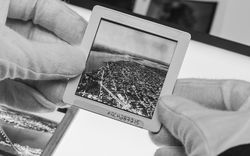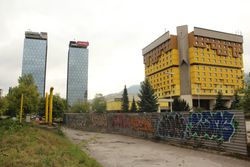articles
Ligne de Fuite
7 septembre 2020
archives
Niveau de description archivistique:
Fonds
Fonds John Hejduk
AP145
Résumé:
The John Hejduk fonds documents the professional practice of architect John Hejduk. Drawings of nearly every project by Hejduk are present, with many of his most significant architectural, exhibition, and publishing projects particularly well represented. Material in this fonds was produced between 1947 and 2000.
1947-2000, predominant 1947-1996
Fonds John Hejduk
Actions:
AP145
Résumé:
The John Hejduk fonds documents the professional practice of architect John Hejduk. Drawings of nearly every project by Hejduk are present, with many of his most significant architectural, exhibition, and publishing projects particularly well represented. Material in this fonds was produced between 1947 and 2000.
archives
Niveau de description archivistique:
Fonds
1947-2000, predominant 1947-1996
Projet
AP018.S1.1972.PR08
Description:
This project series documents the second stage of the expansion of the Art Gallery of Ontario (AGO) in Toronto from 1972-1977. The office identified the project number as 7208. This project consisted of the expansion of the AGO that began in 1972. It was Stage II of the expansion program, which began in 1969 with Stage I. Most prominent in this project was the extension of the gallery’s west side to reach Beverley Street. This wing housed the new Education and Extension (E&E) branch galleries and educational facilities, and a two-storey reference library. The library included a 10,000 square foot reading room and an audiovisual library. This stage also proposed an extension to the south of the main gallery, directly east of the Grange mansion, that would connect the AGO to the neighbouring Ontario College of Art. It should be noted that while AGO project contracts were originally given to John B. Parkin Associates, John C. Parkin continued the project under his new firm, Parkin Architects Planners, after parting ways with partner John B. Parkin in 1971. The project is recorded through drawings, photographs, and textual records dating from 1971-1983. The majority of the drawings are reprographic copies of detail drawings arranged with the textual records, although original drawings of details are also present within the textual records. Large drawings housed separately show both the design development and construction of the project. There are also presentation boards showing floor plan schemes. The textual records include contractor and client correspondence, meeting reports, specifications, project notebooks, tender documents, contract data, consultancy records, site reports, certificates of payment and other financial documentation, change orders, supplementary instructions, deficiency lists, detail planning records, and studies. Box AP018.S1.1972.PR08.001 contains an index to the textual records, which was created by the office.
1971-1983
Art Gallery of Ontario, Stage II Expansion, Toronto (1978)
Actions:
AP018.S1.1972.PR08
Description:
This project series documents the second stage of the expansion of the Art Gallery of Ontario (AGO) in Toronto from 1972-1977. The office identified the project number as 7208. This project consisted of the expansion of the AGO that began in 1972. It was Stage II of the expansion program, which began in 1969 with Stage I. Most prominent in this project was the extension of the gallery’s west side to reach Beverley Street. This wing housed the new Education and Extension (E&E) branch galleries and educational facilities, and a two-storey reference library. The library included a 10,000 square foot reading room and an audiovisual library. This stage also proposed an extension to the south of the main gallery, directly east of the Grange mansion, that would connect the AGO to the neighbouring Ontario College of Art. It should be noted that while AGO project contracts were originally given to John B. Parkin Associates, John C. Parkin continued the project under his new firm, Parkin Architects Planners, after parting ways with partner John B. Parkin in 1971. The project is recorded through drawings, photographs, and textual records dating from 1971-1983. The majority of the drawings are reprographic copies of detail drawings arranged with the textual records, although original drawings of details are also present within the textual records. Large drawings housed separately show both the design development and construction of the project. There are also presentation boards showing floor plan schemes. The textual records include contractor and client correspondence, meeting reports, specifications, project notebooks, tender documents, contract data, consultancy records, site reports, certificates of payment and other financial documentation, change orders, supplementary instructions, deficiency lists, detail planning records, and studies. Box AP018.S1.1972.PR08.001 contains an index to the textual records, which was created by the office.
Project
1971-1983
recherche
Chercheurs virtuels 2023
L’édition 2023 du programme virtuel de bourses de recherche CCA invitait à de nouvelles orientations, lectures et interactions avec les œuvres photographiques de notre collection, afin de déterminer comment une compréhension plus large de la « vision » peut dépasser ce que Vilém Flusser appelle « l’image technique ».
mars 2023 au avril 2023
Chercheurs virtuels 2023
Actions:
Description:
L’édition 2023 du programme virtuel de bourses de recherche CCA invitait à de nouvelles orientations, lectures et interactions avec les œuvres photographiques de notre collection, afin de déterminer comment une compréhension plus large de la « vision » peut dépasser ce que Vilém Flusser appelle « l’image technique ».
recherche
mars 2023 au
avril 2023
articles
À l'horizon
À l'horizon
Gilles Delalex et Yves Moreau de Studio Muoto offrent une relecture des archives d'Amancio Williams
Actions:
Projet
AP018.S1.1972.PR18
Description:
This project series documents the design and construction of a library and an addition to city hall in Fredericton, New Brunswick from 1972-1975. The office identified the project number as 7226. This project consisted of two distinct parts; a public library constructed at the corners of Campbell and Carleton Streets, and an addition to city hall whose original building was constructed at the corners of Queen and York Streets around 1875. These two buildings were located two blocks from one another, but a master plan for the project shows that the separating streets would be removed in favour of a pedestrian friendly landscape. Both buildings were located next to the St. John River. For this project, Parkin Architects Planners partnered with architectural firm Graham Napier Associates to form the joint venture referred to as Graham Parkin Architects Engineers Planners. The brick-clad addition to city hall nearly doubled the square footage of the ground and first floors. The original city hall was four levels and the addition was two, with a mechanical penthouse on top. The new areas included departmental offices such as planning, engineering and sewage, a drafting room, conference room, and reception, among others. The library consisted of a two-storey, brick-clad building that was approximately 24,000 square feet in size with a 16 car parking lot. The ground floor included reception and exhibit areas, stacks, administration offices, bookmobiles, and staff lockers, while the second level had stacks and reading areas, audiovisual areas and a staff work room and break room. The library also had a mechanical penthouse on top. The project is recorded through drawings, including mounted presentation boards, photographic materials and textual records dating from 1972-1978. The drawings consist of original sketches, plans, sections, elevations and details of both city hall and the library, and some drawings used for construction. There are also drawings of the original city hall, first drafted around 1875. The photographs show existing buildings and the construction progress of the project. The textual records consist of correspondence, conference reports, interoffice letters, specifications, consultancy documentation, a soil investigation, research and drawing transmittal records. File AP018.S1.1972.PR18.020 contains an index to the textual materials, which was created by the office.
circa 1972-1978
City Hall and Library Facilities, Fredericton, New Brunswick (1972-1975)
Actions:
AP018.S1.1972.PR18
Description:
This project series documents the design and construction of a library and an addition to city hall in Fredericton, New Brunswick from 1972-1975. The office identified the project number as 7226. This project consisted of two distinct parts; a public library constructed at the corners of Campbell and Carleton Streets, and an addition to city hall whose original building was constructed at the corners of Queen and York Streets around 1875. These two buildings were located two blocks from one another, but a master plan for the project shows that the separating streets would be removed in favour of a pedestrian friendly landscape. Both buildings were located next to the St. John River. For this project, Parkin Architects Planners partnered with architectural firm Graham Napier Associates to form the joint venture referred to as Graham Parkin Architects Engineers Planners. The brick-clad addition to city hall nearly doubled the square footage of the ground and first floors. The original city hall was four levels and the addition was two, with a mechanical penthouse on top. The new areas included departmental offices such as planning, engineering and sewage, a drafting room, conference room, and reception, among others. The library consisted of a two-storey, brick-clad building that was approximately 24,000 square feet in size with a 16 car parking lot. The ground floor included reception and exhibit areas, stacks, administration offices, bookmobiles, and staff lockers, while the second level had stacks and reading areas, audiovisual areas and a staff work room and break room. The library also had a mechanical penthouse on top. The project is recorded through drawings, including mounted presentation boards, photographic materials and textual records dating from 1972-1978. The drawings consist of original sketches, plans, sections, elevations and details of both city hall and the library, and some drawings used for construction. There are also drawings of the original city hall, first drafted around 1875. The photographs show existing buildings and the construction progress of the project. The textual records consist of correspondence, conference reports, interoffice letters, specifications, consultancy documentation, a soil investigation, research and drawing transmittal records. File AP018.S1.1972.PR18.020 contains an index to the textual materials, which was created by the office.
Project
circa 1972-1978
Echosystèmes
Situé à la rencontre d’une méthodologie et d’une production de contenu alternatives, cet atelier public propose d’identifier et de documenter les politiques hétérogènes du quartier entourant le Centre Canadien d’Architecture. Modérée par Léopold Lambert de la plateforme Archipelago, cette journée intensive de réflexion et de création polyphonique abordera les(...)
5 mars 2016
Echosystèmes
Actions:
Description:
Situé à la rencontre d’une méthodologie et d’une production de contenu alternatives, cet atelier public propose d’identifier et de documenter les politiques hétérogènes du quartier entourant le Centre Canadien d’Architecture. Modérée par Léopold Lambert de la plateforme Archipelago, cette journée intensive de réflexion et de création polyphonique abordera les(...)
Salles principales
31 janvier 2019, 18h30
Salles principales
Salles principales
3 octobre 2019, 18h30
Salles principales
Salles principales
12 décembre 2019, 18h30
Salles principales



